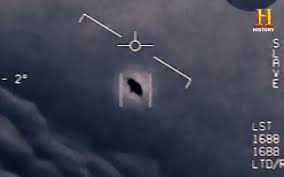|

The USS Nimitz UFO incident refers to a 2004 Radar-Visual encounter of an unidentified flying object by US fighter pilots of the Nimitz Carrier Strike Group. In December 2017, infrared footage of the encounter was released to the public.



A 2015 account of the incident on FighterSweep.com, interviews with one of the pilots, and subsequent news reports describe the sighting of an "unidentified flying object" by six Super Hornet fighter jets over the Pacific in November, 2004. According to The Washington Post, the video was released by former intelligence officer Luis Elizondo to shed light on a secretive Department of Defense operation to analyze reported UFO sightings, the Advanced Aviation Threat Identification Program. Investigator Joe Nickell and astronomer James E. McGaha state that the reported encounter "appears to have been a series of misunderstandings and misperceptions, with no evidence of "an extraterrestrial encounter". Prior to the incident, early November 2004, the Ticonderoga-class guided missile cruiser USS Princeton, part of Carrier Strike Group 11, had been tracking mysterious aircraft intermittently for two weeks on an advanced AN/SPY-1B passive radar. When the same event occurred again around 12:30 EST on 14 November 2004, an operations officer aboard Princeton contacted two airborne US Navy jet fighters from USS Nimitz. The first fighter aircraft was piloted by Commander David Fravor, commanding officer of Strike Fighter Squadron 41, assisted by his weapon systems officer (WSO) in the back seat, and the second was piloted by Lieutenant commander Jim Slaight and his WSO, serving as a wingman. They were then training aboard two FA-18F Super Hornets in a routine combat exercise. Princeton's radio operator first asked the AWACS of the Carrier Airborne Early Warning Squadron 117, which was assisting the two F-18s in their training, to guide them to intercept the unknown aircraft. But as the radar of the Grumman E-2 Hawkeye failed to acquire the target except for a unusable faint plot, Princeton's radio operator directly instructed the pilots to change their course and investigate the unidentified radar spot observed by Princeton's own radar. Princeton's radio operator further asked the pilots if they were carrying operational weapons; they replied that they were not. The weather conditions for that day showed excellent visibility with a blue sky, no cloud cover, and a calm sea. When the jet fighters arrived on site, the crew of four saw nothing in the air nor on their radar. Looking down at the sea, however, they noticed a turbulent oval area of churning water with foam and frothy waves "the size of a Boeing 737 airplane" with a smoother area of lighter color at the center, as if the waves were breaking over something just under the surface. A few seconds later, they noticed an unusual object hovering with erratic movements 50 feet above the boiling water. Both Fravor[11] and Slaight later described the object as a large bright white Tic Tac 30 to 46 feet (10 to 14 meters) long, with no windshield nor porthole, no wing nor empennage, and no visible engine nor exhaust plume. According to Fravor "I have no idea what I saw. It had no plumes, wings or rotors and outran our F-18s. But I want to fly one". Fravor began a circular descent to approach the object, but he claimed[not in citation given] the UFO was intentionally avoiding any short range dogfight radar lock-on with "impossible" maneuvers[not in citation given] that made engagement difficult. As Fravor got closer descending, he reported that the object began ascending along a curved path, maintaining some distance from the F-18, mirroring its trajectory in opposite circles.] Fravor then made a more aggressive maneuver, plunging his fighter to aim below the object, but at this point the UFO accelerated and went out of sight in less than two seconds, leaving the pilots "pretty weirded out". A few minutes later, Princeton reported that the radar spot had reappeared 60 miles away. According to Popular Mechanics, a physical object would have had to move faster than Mach 3.0 to cover such a distance in the reported time. The jets went to investigate the new radar location, but "By the time the Super Hornets arrived the object had already disappeared." Upon losing visual contact with the object, both F-18s were low on fuel and had to return to Nimitz.

After the return of the first team to Nimitz, a second team took off at approximately 15:00 EST, this time equipped with an advanced infrared camera (FLIR pod). This camera recorded an evasive unidentified aerial system on video, publicly released by the Pentagon on 16 December 2017 alongside the revelation of the funding of the Advanced Aviation Threat Identification Program. This footage is known as the 2004 USS Nimitz FLIR1 video. It officially shed some light on a decade-old story that was largely unknown, except for a 2015 second-hand story on FighterSweep.com that, in spite of providing a lot of details, remained unconfirmed at that time. A second infrared footage, known as the GIMBAL video, has been released by the Pentagon alongside the 2004 FLIR1 footage. Although the media often present the two videos together to illustrate the 2004 USS Nimitz UFO incident, the GIMBAL video is unrelated, filmed at the East Coast of the United States at an unknown date.
Book Titles We Highly Recommend - Informative and Fascinating - Helps To Support This Website




|





